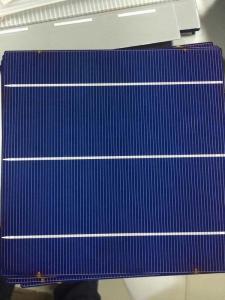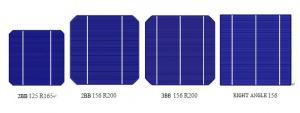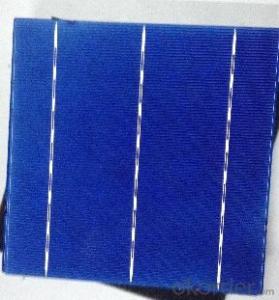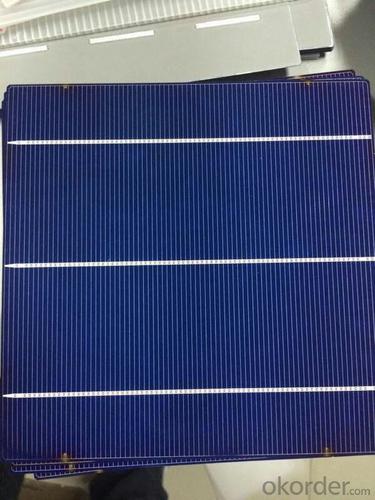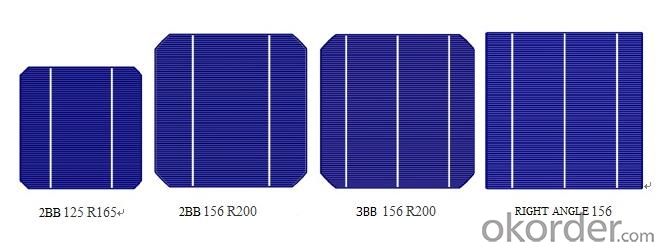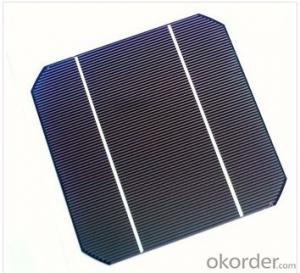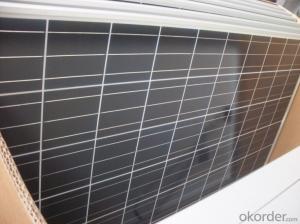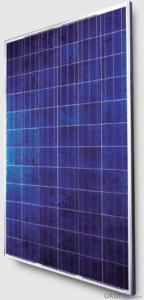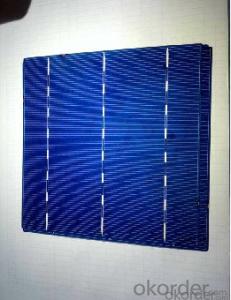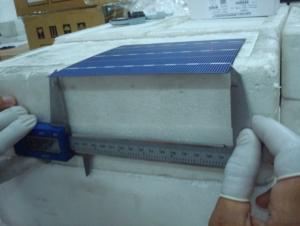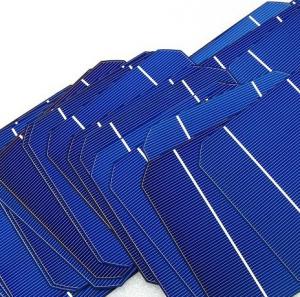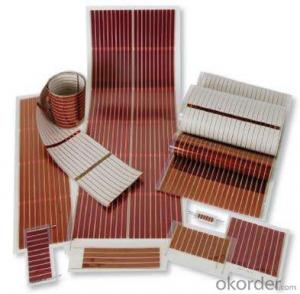Wholesale Solar Cells - Poly Solar Cells 16.8% (CNBM Made in China, Low Price)
- Loading Port:
- Shanghai
- Payment Terms:
- TT or LC
- Min Order Qty:
- 100 PCS
- Supply Capability:
- 1000000 PCS/month
OKorder Service Pledge
OKorder Financial Service
You Might Also Like
Advantages of Poly Solar Cells
1. High efficiency and High power.
2. Long-term electrical stability.
3. Lowest price and Fastest delivery.
4. Good quality and good service.
5. Bulk supply
6. Good Warranty
7. Big Sale
8. More than 25 years on the lifetime.

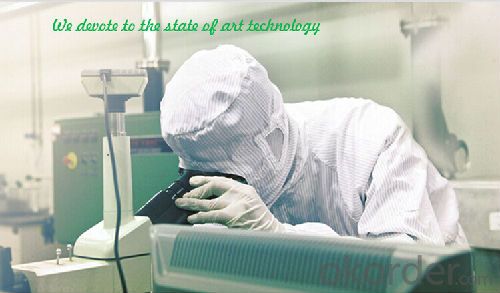
Specifications of Poly Solar Cells
Format 156 mm × 156 mm ± 0.5 mm
Thickness- 210μm ± 40 μm
Front (-) 1.5mm bus bars (silver),blue anti-reflection coating (silicon nitride)
Back (+) 2.5mm wide soldering pads (silver) back surface field (aluminium)
Temperature Coefficient of Poly Cells
Voc.Temp .coef.%/K -0.351%/K
Isc.Temp .coef.%/K +0.035%/K
Pm.Temp. coef.%/K -0.47%/K
Electrical Characteristic of Poly Cells
| Efficiency | Efficiency | Pmax(W) | Average | Impp(A) | Vmpp(V) | Isc(A) | Voc(V) |
| 1720 | 17.20~17.40 | > 4.186 | > 4.186 | 7.94 | 0.528 | 8.515 | 0.626 |
| 1700 | 17.00~17.20 | 4.137~4.186 | 4.161 | 7.905 | 0.525 | 8.482 | 0.624 |
| 1680 | 16.80~17.00 | 4.088~4.137 | 4.113 | 7.863 | 0.521 | 8.402 | 0.623 |
| 1660 | 16.60~16.80 | 4.040~4.088 | 4.064 | 7.825 | 0.519 | 8.358 | 0.622 |
| 1640 | 16.40~16.60 | 3.991~4.040 | 4.015 | 7.769 | 0.517 | 8.304 | 0.621 |
| 1620 | 16.20~16.40 | 3.942~3.991 | 3.967 | 7.713 | 0.514 | 8.248 | 0.619 |
| 1600 | 16.00~16.20 | 3.894~3.942 | 3.918 | 7.67 | 0.511 | 8.204 | 0.616 |
Usage and Applications of Poly Cells
Solar cells are often electrically connected and encapsulated as a module. Photovoltaic modules often have a sheet of glass on the front (sun up) side, allowing light to pass while protecting the semiconductor wafers from abrasion and impact due to wind-driven debris, rain, hail, etc. Solar cells are also usually connected in series in modules, creating an additive voltage. Connecting cells in parallel will yield a higher current;our solar cells have passed IEC Certification. With high quality and stable quality. Our Cells can greatly improve the performance of Solar Modules.
Packaging & Delivery of Poly Cells
Carton Box Package and Deliver by air. It should be noticed that it should be avoid water, sunshine and moist.
FAQ:What's your products warranty?
•: No less than 90% within 10years and no less than 80% within 25years. Less power decrease.
FAQ: How many kinds of solar cells can we produce?
•: We can supply the normal 2 kinds of solar cells, Poly 156mm*156mm and Mono125mm*125mm , and the special demension also can be produced .
FAQ:What's the effeciency range of the solar cells?
•: We can supply 16.8% to 18.9% effeciency of the solar cells.
- Q: Can solar cells be used in disaster relief or emergency response situations?
- Yes, solar cells can be used in disaster relief or emergency response situations. Solar cells provide a reliable and renewable source of energy that can be used to power critical devices and infrastructure such as communication systems, medical equipment, lighting, and water purification systems. They are easily deployable, independent of the electrical grid, and can operate in remote areas, making them ideal for emergency situations where access to traditional power sources may be disrupted.
- Q: How do solar cells perform in regions with high levels of humidity and rainfall?
- Solar cells can still perform well in regions with high levels of humidity and rainfall. While excessive moisture can temporarily reduce their efficiency, modern solar cell designs are built to withstand such conditions. Additionally, rainwater can actually help to clean the surface of the solar panels, improving their performance in the long run.
- Q: How do solar cells perform in different geographical locations?
- Solar cells perform differently in different geographical locations due to variations in sunlight intensity, duration, and angle of incidence. Generally, solar cells perform better in regions with abundant sunlight and longer daylight hours, such as equatorial regions, deserts, and areas with minimal cloud cover. However, solar cells can still generate electricity in less sunny locations, albeit with reduced efficiency. Factors like temperature, air pollution, and shading from trees or buildings can also affect solar cell performance. Overall, the geographical location plays a crucial role in determining the energy output and effectiveness of solar cells.
- Q: What is the role of silicon in solar cells?
- The role of silicon in solar cells is to act as a semiconductor material that can absorb sunlight and convert it into electricity through the photovoltaic effect. Silicon is the most commonly used material in solar cell manufacturing due to its abundance, stability, and ability to efficiently convert sunlight into electricity. It forms the basis of the p-n junction, which allows for the separation and movement of electrons and holes, generating an electric current.
- Q: What is the impact of dust storms on solar cell efficiency?
- Dust storms can significantly reduce solar cell efficiency by blocking sunlight and accumulating dust particles on the surface of the cells. The dust particles act as a barrier, preventing sunlight from reaching the cells and reducing their ability to generate electricity. This can lead to a decrease in power output and overall efficiency of the solar panels. It is essential to regularly clean and maintain the solar panels to mitigate the negative impact of dust storms and ensure optimal performance.
- Q: What is the impact of solar cell installations on job creation?
- The impact of solar cell installations on job creation is significant. As the demand for renewable energy continues to grow, the solar industry has experienced substantial job growth. Installing solar cells requires a skilled workforce, creating employment opportunities in manufacturing, installation, maintenance, and sales. Moreover, the development of solar projects stimulates local economies, attracting investments and creating jobs in related sectors such as engineering, finance, and construction. Therefore, solar cell installations have a positive impact on job creation, fostering a sustainable and thriving green economy.
- Q: Can solar cells be used for off-grid living?
- Yes, solar cells can be used for off-grid living. Solar panels can generate electricity from sunlight, which can then be used to power various appliances and devices in a home or building. This eliminates the need for being connected to the traditional power grid, making it a sustainable and independent energy solution for off-grid living.
- Q: Can solar cells be used in water heating systems?
- Yes, solar cells can be used in water heating systems. Solar water heating systems use solar thermal collectors, which consist of solar cells that convert sunlight into electricity. This electricity is then used to heat water, making it a sustainable and environmentally friendly option for water heating.
- Q: How do solar cells perform in areas with frequent hurricanes?
- Solar cells can perform well in areas with frequent hurricanes, provided they are properly installed and designed to withstand high winds. It is important to use durable materials and secure mounting systems to ensure their stability during extreme weather events. Additionally, incorporating protective measures such as storm shutters or reinforced frames can help safeguard the solar panels during hurricanes.
- Q: What is the impact of solar cells on reducing air pollution from power generation?
- Solar cells have a significant impact on reducing air pollution from power generation. By harnessing energy from the sun, solar cells produce electricity without emitting harmful pollutants such as carbon dioxide, sulfur dioxide, or nitrogen oxides. This clean and sustainable energy source helps to mitigate the negative effects of traditional fossil fuel-based power generation on air quality, thus contributing to a healthier environment and reducing the overall carbon footprint.
Send your message to us
Wholesale Solar Cells - Poly Solar Cells 16.8% (CNBM Made in China, Low Price)
- Loading Port:
- Shanghai
- Payment Terms:
- TT or LC
- Min Order Qty:
- 100 PCS
- Supply Capability:
- 1000000 PCS/month
OKorder Service Pledge
OKorder Financial Service
Similar products
Hot products
Hot Searches
Related keywords
